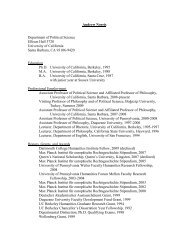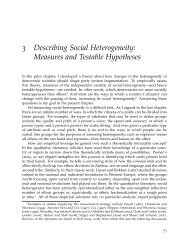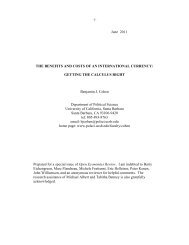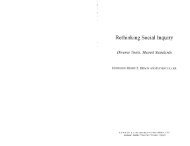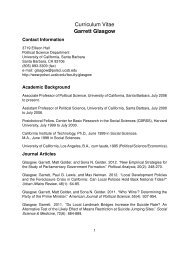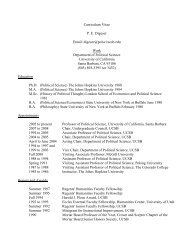-1- May 2012 THE YUAN'S LONG MARCH* Benjamin J. Cohen Can ...
-1- May 2012 THE YUAN'S LONG MARCH* Benjamin J. Cohen Can ...
-1- May 2012 THE YUAN'S LONG MARCH* Benjamin J. Cohen Can ...
You also want an ePaper? Increase the reach of your titles
YUMPU automatically turns print PDFs into web optimized ePapers that Google loves.
-4-<br />
Though no precise date can be identified when Beijing first leaned toward the goal of<br />
internationalization, a key turning point came in 2006 with publication of a report on “The<br />
Timing, Path, and Strategies of RMB Internationalization” by a study group set up by the<br />
People’s Bank of China (PBOC), China’s central bank (PBOC Study Group 2006). “The time has<br />
come for promotion of the internationalization of the yuan,” the study group argued.<br />
Internationalization “can enhance China’s international status and competitiveness significantly<br />
[and] will increase its influence in the international economy.” China will “have a greater say”<br />
and will enjoy “a rise in power standing.” We “should take advantage of the opportunity,” the<br />
report concluded. Internationalization is “an inevitable choice.”<br />
Many in China’s leadership evidently agreed. Within government and party circles a<br />
distinct shift of attitude soon became apparent, spurred in particular by the financial crisis that<br />
struck the world economy in 2008. With its vast hoard of dollar reserves, Beijing had every<br />
reason to feel vulnerable to a sudden shift of exchange rates. Internationalization of the yuan<br />
might provide a useful means to reduce dependence on America’s greenback.<br />
Elite opinion has by no means been unanimous. In fact, divisions over the issue have been<br />
evident in Beijing for some time. On the one side are factions led by the PBOC, who see<br />
internationalization as a means to push forward with liberal financial reforms. On the other side<br />
are a range of producer interests fearful that wider use of the yuan might drive up its value,<br />
eroding export competitiveness, as well as banks and state-owned enterprises that have long<br />
benefitted from the government’s firm controls over interest rates and credit allocation. Internal<br />
cleavages are probably the reason why, to this day, there has never been a formal declaration<br />
pronouncing internationalization official Chinese policy. Judging from Beijing’s actions,<br />
however, it seems quite clear which way the prevailing wind is blowing. By late 2009, as one<br />
observer has put it, “The Chinese Government obviously changed its mind and became<br />
enthusiastic about RMB internationalization” (Zhang 2009: 24). By 2011, internationalization<br />
had assumed a place “at the heart of China’s financial strategy,” according to an influential<br />
advisor to the PBOC. 3<br />
But how was the goal to be achieved? Up to the time of the PBOC’s Study Group report,<br />
China had one of the most tightly controlled currencies in the world, hemmed in by all manner of<br />
exchange restrictions and capital controls. How could cross-border use of the RMB be promoted<br />
if the money was not easily convertible? Moreover, the country’s leadership knew that there was<br />
no successful model in recent history for manufacturing an international currency. They had no<br />
road map to help guide their actions. Not surprisingly, therefore, the government’s approach has<br />
been noticeably cautious, a careful choreography stressing gradualism above all. Following Deng<br />
Xiaoping’s dictum to “cross the river by feeling the stones,” strategy has developed incrementally<br />
in multiple small steps. China’s ruling Communist Party is no stranger to the idea of a Long<br />
March.<br />
Effectively, managed internationalization has been pursued along two interrelated tracks<br />
(Subacchi 2010). One track focuses on cultivating use of the RMB in foreign trade. At the<br />
official level, currency swap agreements with foreign central banks have been initiated facilitating<br />
use of the RMB as a means of payment. At the private level, regulations have been gradually<br />
eased to permit more trade transactions to be invoiced and settled in yuan, bypassing traditional<br />
invoicing currencies like the dollar. The other track focuses on use of the RMB in international




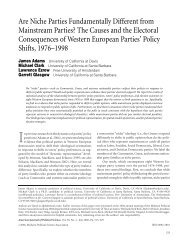
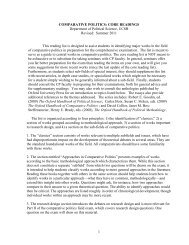
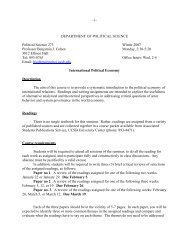

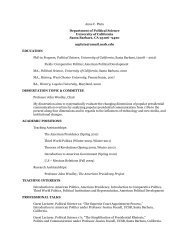
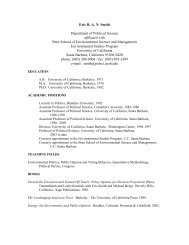
![Curriculum Vitae [abbreviated] John T. Woolley Professor of Political ...](https://img.yumpu.com/25423597/1/190x245/curriculum-vitae-abbreviated-john-t-woolley-professor-of-political-.jpg?quality=85)
